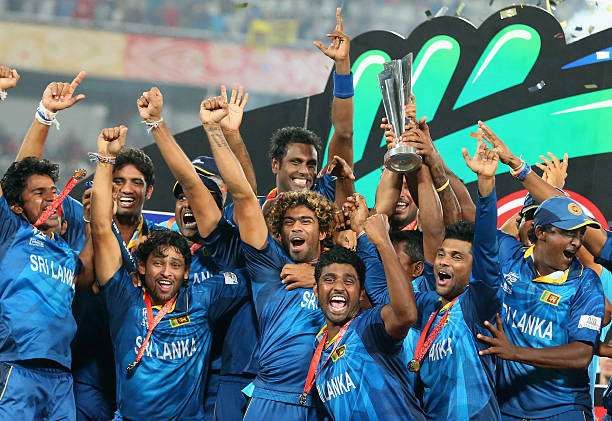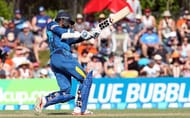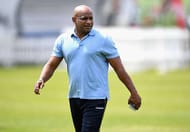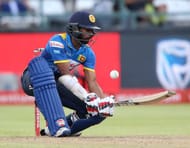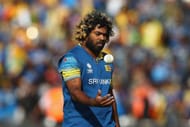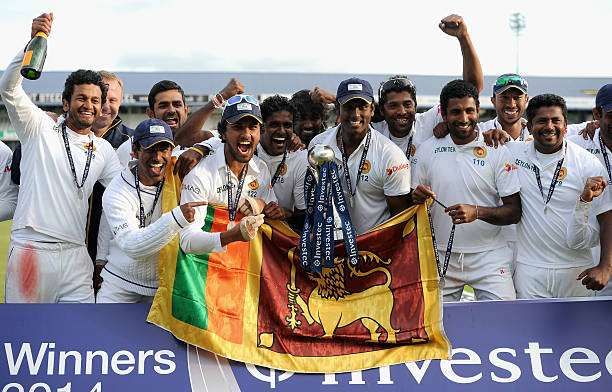Angelo Mathews had the worst job in the world. He knows it, we know it. Hell, even Sri Lanka Cricket, which always seems to know nothing, knows it. It’s an indelible fact of life. Men who stand in the bathrooms of fancy restaurants, offering a napkin to their condescending guests, pity this man for his career choices.
What self-respecting 30-year-old man works four jobs, 11 years into his professional life? Captain, batsman, bowler and negotiator was possibly just a few too many caps for someone who has had to bear the burden of over 300 for his country.
Look, I’m not saying that you were overworked, Mr. Mathews, I’m saying you were physically falling apart by the stress of captaining the frankly incompetent rabble that is your team, in one of the worst administrative environments known to man.
Had you given the job another year and you’d have looked more like Rangana Herath than your old self. We’ve all seen the wrinkles, stretching centimetre by centimetre, we’ve seen the growing resignation in press conferences and we’ve seen the increasing frequency of your injuries. Nobody blames your decision to give up the captaincy.
You’re not just a team man, you’re the team man. Everyone saw you hobbling through your runs, playing through an injury for the sake of the team. Don’t worry, Mr. Mathews. This is not about your failings as a captain, your mistakes or even your shortcomings with the bat in recent times.
This is about how a team and a board managed to break their star player’s spirit, how they robbed Mathews of his youth, his energy and took the Lion out of one of Sri Lanka’s finest players.
***
In 2014, Sri Lanka arguably hit their peak. They beat India in a World T20 final, they beat England in a Test and ODI series away from home, beat Pakistan in Tests and ODIs at home and beat Bangladesh in Tests away. With this résumé, had Sri Lankan Cricket in 2014 applied for an internship, it would be made the CEO.
Sri Lanka reached such an incredible high point that even in their incompetency, like Rangana Herath walking for a ball he wasn’t out to, they somehow managed to win series. Such were the heights they reached, that for a few brief moments, Nuwan Pradeep looked a proper Test batsman.
You need to understand. They were destined to win everything. 2014 was their year. Eranga was Dale Steyn that year, Sangakkara was Bradman, and Angelo, he was Sobers. This was a year that was so great for Sangakkara that no batsman in the history of cricket scored more runs in a calendar year than Sanga did in 2014.
Mathews himself found himself at 4th place on that very same list for his efforts in 2014. 2014 was just something else for Sri Lanka. They played out of their skins, they became the Lions they talk so much about. It was a swansong, it was a party, it was their destiny.
2014 is gone. Long gone.
In 2017, Team Sri Lanka hit its nadir. And it’s only July. As a fan of Sri Lankan cricket, it pains me to list the depths to which it has sunk since 2014. This is not a list for the faint hearted, and it is in your best interests to skip over to the next paragraph if you are prone to heart conditions, are with child or were old enough to have watched Sri Lanka win the 1996 World Cup.
Sri Lanka started the year with a 3-0 loss to South Africa in a Test series in South Africa. Okay, that’s acceptable. They then lost 5-0 in the ODI series. Okay, South Africa are the number 1 ODI team, it’s okay. Then, they took a T20 series against a second string Australian team by the skin of their teeth. They then returned home to play Bangladesh, losing a Test, an ODI and a T20 to them, eventually drawing all three series 1-1.
At this point, Dimuth Karunaratne declared that a loss to the lowly Bangladesh would “scar” Sri Lankan cricket.
Little did he know that that would be one of Sri Lanka’s better outings. They then went to England early, to prepare for the Champions Trophy and scheduled a couple of informal warm-up games against Scotland. Fielding a strong side, Sri Lanka were easily thwarted by Scotland in the first unofficial ODI.
They won the second, but that’s little consolation for a team that just lost to Scotland. They then capitulated against South Africa, somehow pulled off a win against India and had a genuine chance to make it to the semi-finals of the Champions Trophy.
Not if Sri Lanka had anything to do with it. Dropping an absolute dolly at mid-on, Thisara Perera ensured his side could not get over the line, and his team took an early flight back to Colombo. Ahh!! nice easy sailing now. An easy tour against Zimbabwe, then on to bigger and better things, am I right? No. They lost dismally against Zimbabwe in the ODIs, at which point Mathews finally conceded to the media, that Sri Lanka had hit a low point.
Let us take this opportunity to talk about every Sri Lankan selector, administrator, coach, captain and fan’s favourite two words, “transition phase”. Sangakkara and Jayawardene were the best things to happen to Sri Lankan batting, but they’ve moved on in their lives. And I know Sri Lankan cricket is taking the break-up quite hard, but let’s actually take some time to think about this.
From the 2014 ODI squad for the England series, two players retired, Dilshan was forced out and Herath retired from limited overs’ cricket. Sri Lanka’s batting is not their problem today. If their current top six are persisted with till the World Cup, they might even become formidable. It’s their bowling that leaks runs like an out of funk tap.
You cannot tell me that losing a spinner who played just 71 ODIs at a bowling average of above 31 meant the collapse of the entire bowling lineup. When South Africa lost Graeme Smith, Jacques Kallis and some other players to Kolpak deals in 2014, they barely flinched. Three years later, they have lost more than 10 of their top tier players, but still hold on to the ODI #1 rank and the #2 Test Rank. It’s not a fluke, it’s continued and repeated faith in the same group of players till they succeed.
Had someone like Nuwan Pradeep, a good Test quality bowler, been given regular opportunities since his debut in 2011, he could have been their pace-bowling spearhead right now. Now he’s older and and more prone to injuries, not dissimilar to Sri Lankan cricket.
Frankly, it is embarrassing. I understand that bad years happen. Games are lost by chance sometimes. Not this year. Sri Lanka have been outplayed in the games they’ve been comprehensively beaten, and been undone by their own shoddiness in ones they’ve inexplicably lost. Something is wrong; it’s not just one or two players, but something is just very fishy with the team environment, and the way cricket is being run in Sri Lanka.
The players seem unmotivated, the fans seem reluctant and the team’s energy levels are so low that the Bhabha Atomic Research Centre has sent its top scientists to investigate whether Sri Lanka have achieved absolute zero. This Sri Lanka are the demonic opposites of the team from 2014, with many of the same names and faces bouncing around the national setup, but none of the same personalities stepping up.
Quo Vadis
Quo Vadis is latin for “Where are you going?”. In three tweets, Kumar Sangakkara asked Cricket Sri Lanka just that. He made a simple case that players need to be given time, patience and nurturing before they succeed at the international level. He said that with a little administrative nous, resurgence is a possibility. It’s a good point, undoubtedly.
But then I see where Sanga is coming from. In 2011, Sangakkara gave the MCC Spirit of Cricket lecture. In the 8000-word speech, he explained the roots of cricket in Sri Lanka, the historical significance it has, the value of the game in the island. He delved into the change of cricket from an elite to a common man’s game, telling listeners how the 1996 World Cup unified the nation.
In the hour long speech, he promoted positivity, optimism and love for Sri Lanka’s rendition of the game, demonstrating how their ability to convert talented players was unparalleled. The second half of his speech explained the need for proper, non-political governance of the SLC and a condensed domestic structure.
This speech, while it might not have been heard by everyone back home, was the answer to “Quo Vadis”, the question Sri Lankan cricket has asked itself numerous times since it began its uncontrolled expansion. This was where Sri Lankan cricket was going. Upwards and onwards. All the administrators had to do was manage the growth.
They messed it up.
Every few days, a cricket story comes out that just makes me take a step back from my laptop and ask myself, “What on Earth is going on?”. Sri Lankan cricket’s continued failures have made me less shocked, and more resigned with every humiliating loss and every press conference.
Watching Angelo Mathews, the man that lifted the T20 World Cup in 2014, morosely explain to reporters that they are in a transition phase and that the bowlers didn’t perform and that the batsmen need to take responsibility, is an insult to the fabric on which cricket was built.
So now, Sri Lanka, we are going to look at exactly where you are going and see why you are stumbling so much getting there.
Selection Policy
In the last two years itself, Sri Lanka have seen three different fast bowlers named Fernando debut, none of whom have been persisted with. Sri Lanka Cricket likes to flirt with many players at once, you see. There is no hierarchy as to who is in line for a call-up.
Dasun Shanaka, Dhammika Prasad, Shaminda Eranga, Isuru Udana, Avishka Fernando, Vishva Fernando and Lahiru Kumara have all been snubbed. Perhaps some of them will get Thilanga Sumathipala to blow them a kiss in the future, but for others, Sri Lanka Cricket has already swiped left and blocked them on Facebook, Twitter, Instagram and Snapchat, writing them off without giving them a proper chance.
This is the fast bowling lineup that a year ago, Sanath Jayasuriya, the chief selector, called the best bowling line-up in the world. Spin bowlers come and go. Seekkuge Prasanna is out this time. Too bad, he seemed like he actually had potential. They swapped him with a like for like replacement in Wanidu Hasaranga. Dilruwan Perera, Dhananjaya de Silva, Sachith Pathirana and Amila Aponso have all disappeared, snubbed by a selection committee gone mad on their own egos.
Players need to be given a longer leash. The selection committee looks at players the way they are as soon as they come into the set up. In the first three years of his ODI career, Sangakkara averaged under 26. Players need to be given time to adapt to the international game. Selectors also seem keen to blood as many bits-and-pieces all-rounders as physically possible. In Sri Lanka’s team for the Zimbabwe ODIs, there wasn’t a single pure batsman. Players like that are not sustainable long-term fixes for a team.
A big contributor to this phenomenon is domestic statistics. The domestic competitions are not competitive. A bits and pieces all-rounder, like Wanidu Hasaranga, averages 45+ with the bat and under 25 with the ball in first-class cricket. These numbers do not translate accurately, but they do put pressure on selectors to replace players who are not performing almost immediately with new faces.
Every series has at least one or two extremely young debutants, while players ‘in line’ are casually brushed off. The problem, like many other problems in Sri Lankan cricket, is in the domestic structure.
Domestic Structure
Sri Lanka have five major domestic competitions. They have 23 first-class teams. The mind boggles as to the dilution of talent at the first-class level, if a country as small as Sri Lanka feels the need to have that many first-class teams. SLC president, Thilanga Sumathipala, justified this move as an initiative to raise money for the smaller clubs, as making them first-class teams allowed them greater funding.
The first-class season is also held infrequently. It has not been held for the last two years to prepare for the Champions Trophy – neither is that a move that makes sense, nor does it work in the long run. The first-class teams very rarely develop their players’ fitness, diet and fielding, and as a result, the national team’s fielding is appalling.
The domestic structure’s verbosity forces teams to play club level cricketers at the first class level, making the highest level of domestic cricket a mix of players who are realistically up for national selection, and others who are just your average club cricketers. Consequently, first-class and List A records are skewed heavily, making selectors’ lives hell, and not allowing first-class players to be trained properly for international cricket.
Sri Lanka also do not have a domestic T20 league, which is one of the causes for their lack of resources. As a result, few clubs can afford proper groundskeeping facilities, leading to slow and spinning wickets all over the country.
Sri Lanka’s shocking tour of England in 2016 was a testament to the fact their players were just not ready to play a seaming ball. The domestic structure also lacks the requisite talent scouting services other major teams have. Age group structures aren’t attended by scouts, leading to the unorthodox talent that Sri Lanka prides itself on slipping through the cracks.
Sri Lanka Cricket: The worst cricket board?

A majority of the issues are direct failures of Sri Lanka Cricket. A board with a history of pay disputes, poor management, ego clashes and strange media interaction is the leading cause of instability in Sri Lankan cricket. Their mismanagement of Sri Lanka Cricket funds, poor handling of the coaching staff, absurd policies and the ridiculous domestic set up was a landslide waiting to happen. Now that landslide has hit. Mathews has resigned, the team is in shambles and the SLC’s coffers aren’t doing much better.
The administration was so intent on getting the spotlight that they looked for quick-fix solutions to Sri Lanka’s structural problems. Recurring injuries to fast bowlers? Field inexperienced debutants instead of hiring proper physiotherapists. Inconsistent batting lineup? Switch the players around in a hellish game of musical chairs. It is time to take the duct tape away from Sumathipala’s SLC, and show him that the dam just burst.
Mixing politics and sports is dangerous. In the subcontinent, cricket boards are run by industrialists and politicians, using the country’s cricket team as their personal vote swinger. Players are not chosen for their skills but their political appeal, and in a country as fractured on race and religion as Sri Lanka is, this is particularly effective. Getting rid of politicos in cricket administration can only be a good thing.
Cricket administration without the egos, without the conflicts of interest and without the dual agendas will be a giant step forward for Sri Lanka. This also goes for ex-players that have turned to politics, like Jayasuriya. It’s a strange predicament to be in, where former players are given the power to look after Sri Lankan cricket, but end up caring solely about their vote banks.
A job too far?
Sri Lanka have done an excellent job of finding coaches for their national team. Stuart Law is now in charge of the West Indies, Trevor Bayliss and Paul Farbrace led the renaissance of England’s white-ball game, Chandika Hathurusingha has brought Bangladesh to the world stage and Graham Ford was actually willing to be patient and work with Sri Lanka at a minimal pay in an effort to rebuild the team. The part Sri Lanka weren’t so good at was hanging onto these guys.
The SLC was looking for quick fixes to a Sangakkara and Jayawardene sized crack, and they were willing to get rid of as many coaches as they needed to make that happen. And they did. Now, they’re left with Nic Pothas as interim coach while the SLC scrambles for funds to pay a brand new coach to bully ahead of the India series.
Get over yourself, Sri Lanka Cricket. These are good men who just want what’s best for you. That’s more than can be said for you lot. The ways and means the SLC took to get rid of each coach was despicable.
Ford was forced out by the appointment of a team manager, who rendered him sort of redundant. The SLC has also been largely erratic with how many coaches they want to hire. They’ve sent their team off to tours without batting and full-time fielding coaches in the past, then blamed captains and players for losing games. The next coach of Sri Lankan cricket had best be a local, someone who wields enough power in the system to get his way, despite the frankly incompetent SLC.
Where now for the current team?
Sri Lanka have appointed Upul Tharanga as the ODI captain and Dinesh Chandimal as the Test captain. This means that the batting lineups in the two formats are more or less settled, with just the opening slot in Tests under a bit of scrutiny. With a somewhat settled top six, it is just a matter of giving this batting lineup a chance to settle down, and find its footing under new leadership, both coaching and captaincy.
The Test team will also need to take a call as to whether or not to continue with Niroshan Dickwella at 7 in Test matches, relieving Chandimal of the gloves and allowing a player in the mould of Quinton de Kock in the lower middle order (and I’m not talking about their names). With some good coaching, practice and game time, this lineup has the potential to score big runs. Its balance, with a mix of patience and aggression, youth and experience is encouraging, but it will take time for them to find success.
In ODIs, the batting has been pretty good. The openers are fiery, the middle order is pretty solid, Gunaratne is a pretty good finisher, but they lack an aggressive bowling allrounder who can swing the long handle. With that, and again, time, they will be a decent batting lineup.
The bowling is where serious concerns are to be raised. In Test matches, their star bowler is 39 years old and on the brink of retirement. In Lakshan Sandakan they have a talented young bowler who needs time and nurturing to become the next in a line of successful Sri Lankan spinners.
His partner, DIlruwan Perera is also talented and the pair will need to work with spin coaches to adapt their craft for Sri Lanka’s away tours as well. Malinda Pushpakumara, a stalwart of the domestic setup could also be in line to replace Herath. His left-arm orthodox would be a challenge on the turning pitches even at the international level and his experience in first-class cricket makes him an obvious choice.
However, in limited overs cricket, the spin combination has been swapped around more than twins in a poorly made romantic comedy. Sandakan is a good bowler who happened to have a few bad games. Don’t get rid of him. Gunaratne is good playing a holding role, getting the occasional wicket, but Sri Lanka will need another proper wicket-taking option to pair Sandakan.
Wanidu Hasaranga shows promise, and again, needs game time, coaching and security about his place in the team to blossom. Other options for limited overs’ games are Jeffrey Vandersay and Seekkuge Prasanna, wicket-taking leg spinners who have been discarded prematurely by the SLC.
The pace bowling is, frankly, in shambles. Nuwan Kulasekara and Lasith Malinga are two middle-aged uncles at an under-21 nightclub these days, but don’t mind that, they will always have a special place in the selectors’ hearts, making their way back into the side no matter how poorly they perform. The selectors need to ask the veteran pair if they will be able to make it to the 2019 World Cup. If they cannot, they have to be slowly weaned out.
Sri Lanka have inexplicably unearthed some pretty good pace bowling talent in recent times, a testament to the fact that if you throw enough mud at a wall, eventually some sticks. Lahiru Kumara, Nuwan Pradeep, Dushmantha Chameera, Dasun Shanaka and even Suranga Lakmal are good bowlers, whose talents just have not been utilised correctly. Chameera was brought back half-baked, not being able to hit the high 140kph mark he was on the team for.
Lahiru Kumara made his ODI debut before having played any List A games and was then dropped from the Test team, after a pretty good South Africa Test series. The most curious case is Dasun Shanaka, who took the wickets of three top-order England batsmen, yet found himself without a second Test match. Injuries have plagued their fast bowling arsenal for a while now. Chameera had a stress fracture, Prasad’s injuries may have ended his career, Lakmal is ill at the moment and Pradeep is the latest casualty, with a side strain.
Is the injury prevention system that poor, or are bowlers just grossly mismanaged? In my opinion, Kumara, Pradeep, Chameera and Shanaka (overseas) are players with serious potential and need to be persisted with. If Malinga can bowl like he did in the final spell against Zimbabwe, his selection is a must as well, form and fitness allowing. Isuru Udana is a talented bowler for the limited overs games, and his death bowling could make him the natural successor to Lasith Malinga.
***
In the 5th ODI vs Zimbabwe, the ball was hit down to long-on, where Malinga was stationed. The ball came on the bounce at a comfortable height, a regulation collection for any under-thirteen 3rd XI cricketer. Not for Lasith Malinga. In a move that seemed to defy logic and physics, he found a way to rebound the ball for a boundary. This was not even the worst mistake of the game.
Sri Lanka had a legitimate chance to qualify for the Champions Trophy semi-finals. They had Pakistan 7 down, with more than 40 runs still to get. Sarfraz was leading the chase. He then spooned a catch to mid on.
This was catching practice for a village team of 60 years olds. It was undroppable. Thisara Perera dropped it. Sri Lanka Cricket dropped him. It would take a team of highly skilled data scientists to compile a list of all of Sri Lanka’s errors in the field, a luxury I don’t have. Nor do I subject my readers with gory findings. This is a PG-13 publication, after all.
Fielding has been the bane of Sri Lankan teams in the past, but this one is full of young, agile players. They should be able to cover ground quickly and dive for catches. According to the SLC president himself, the fielding in the lower divisions is very poor, something players then take to the international stage and he, for once, is right. You cannot be teaching your Test level fast bowlers how to dive and catch.
Fielding standards need to be built at a domestic level. With proper fielding training for club and domestic teams, the ‘mystery players’ Sri Lanka is famous for producing will also be livewires on the field. I never thought I’d say this, but look at Pakistan. While the old dogs are sluggish in the field, the debutantes and newer additions are absolute guns. Shadab Khan, Fakhar Zaman and Imad Wasim are the best fielders in the team.
***
Angelo Mathews arrives in Colombo to play the final game of the series, a Test. He looks a younger man. His hair is darker, his paunch less visible. His shoulders bolt upright, his back not cowering for fear of a question about Sri Lankan cricket. He’s a new man because he’s not riddled with the expectations that come with being Sri Lanka. For years they languished in minnow hood, but Sangakkara, Jayawardene and gang were the shot in the arm that their cricket needed. Now they face the burdens of past achievements.
Logic says Sri Lanka, armed with exactly one Rangana Herath, should destroy Zimbabwe, but without the fighting spirit that made Sri Lankan cricket strong despite terrorists and a broken administration, I’m not so sure they could even overcome themselves. The ‘mystery’ spin, the strange shots, the guy who swings his arm through at shoulder height, they’re not a result of unconventional coaching methods. It’s innovation.
It’s a country doing anything to be relevant in a world better funded and safer than its own. It’s a country using its wiles and spirit and pure passion for the game to overcome tanks and good length balls. It’s all the same, you see. It’s survival at all costs, and that is why Sri Lankan cricket is worth fighting for.
Sangakkara ended his Cowdrey Lecture saying, "I am Tamil, I'm Sinhalese, I'm Muslim and Burgher. I'm a Buddhist, I'm a Hindu, a follower of Islam and Christianity. But above all, today and always I will be, proudly, Sri Lankan." Sri Lanka can change coaches, teams and even their administration, but they will not succeed until they channel the spirit of what it means to be Sri Lankan.
Looking for fast live cricket scores? Download CricRocket and get fast score updates, top-notch commentary in-depth match stats & much more! 🚀☄️

